Gender Differences in Fatigue Among Jordanian Nurses: A Study
VerifiedAdded on 2022/10/01
|6
|2225
|14
Report
AI Summary
This report investigates the issue of fatigue among nurses in Jordan, a nation with a growing healthcare system facing increased demands due to regional conflicts and a rising patient load. The study aims to identify fatigue levels and individual risk management strategies employed by both male and female nurses, exploring potential differences in their experiences and expectations. It highlights factors contributing to fatigue, such as nurse shortages, challenging work environments, and cultural and religious considerations affecting patient care. The research delves into the prevalence of fatigue, its negative consequences, and the importance of effective risk management strategies to mitigate its impact on both nurses and patient safety. It emphasizes the need for comprehensive studies to develop policies and strategies that reduce fatigue and promote healthy coping mechanisms within the nursing workforce in Jordan. The report references various studies highlighting the prevalence of fatigue in different countries and the crucial role of nurses in the healthcare system.
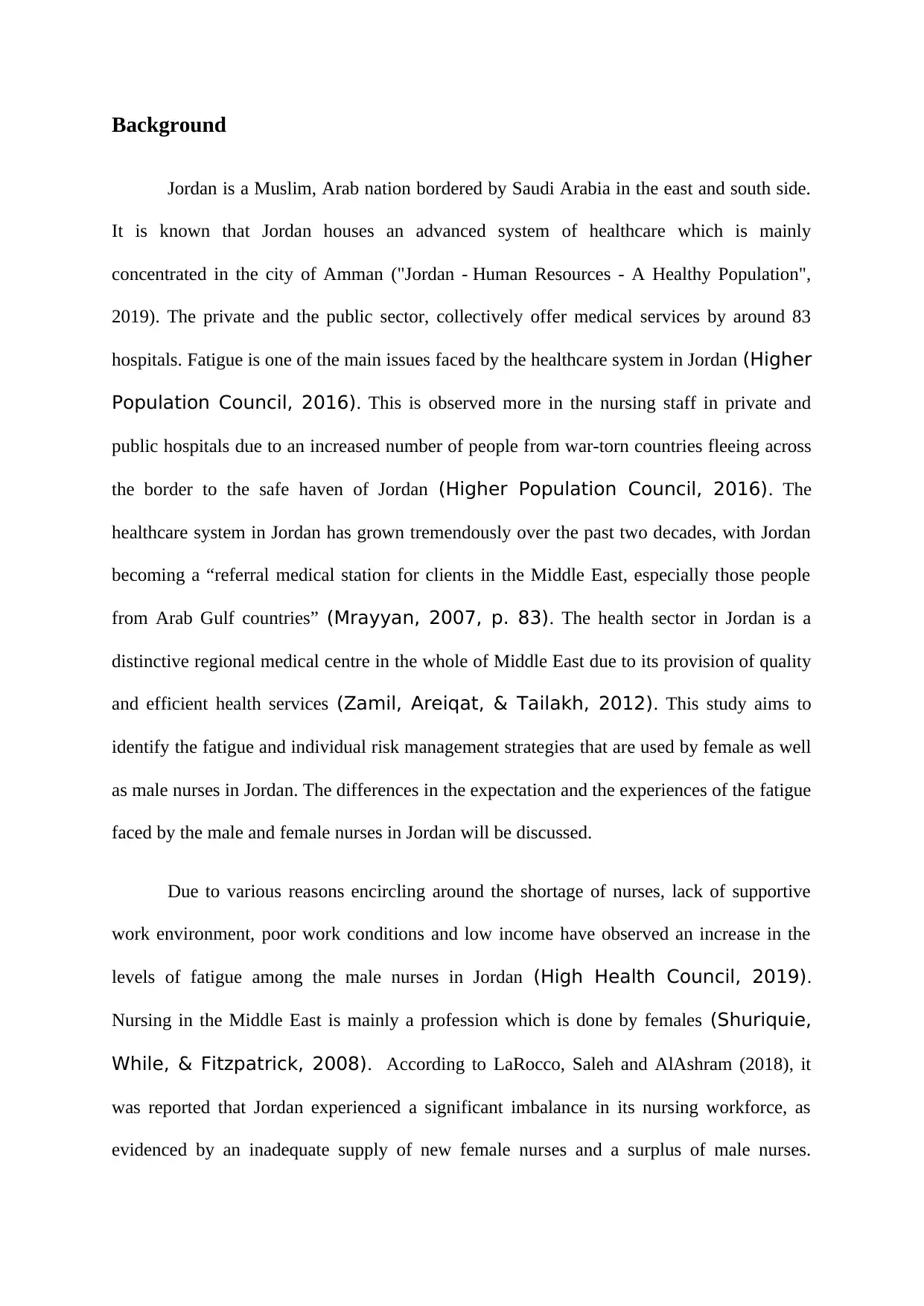
Background
Jordan is a Muslim, Arab nation bordered by Saudi Arabia in the east and south side.
It is known that Jordan houses an advanced system of healthcare which is mainly
concentrated in the city of Amman ("Jordan - Human Resources - A Healthy Population",
2019). The private and the public sector, collectively offer medical services by around 83
hospitals. Fatigue is one of the main issues faced by the healthcare system in Jordan (Higher
Population Council, 2016). This is observed more in the nursing staff in private and
public hospitals due to an increased number of people from war-torn countries fleeing across
the border to the safe haven of Jordan (Higher Population Council, 2016). The
healthcare system in Jordan has grown tremendously over the past two decades, with Jordan
becoming a “referral medical station for clients in the Middle East, especially those people
from Arab Gulf countries” (Mrayyan, 2007, p. 83). The health sector in Jordan is a
distinctive regional medical centre in the whole of Middle East due to its provision of quality
and efficient health services (Zamil, Areiqat, & Tailakh, 2012). This study aims to
identify the fatigue and individual risk management strategies that are used by female as well
as male nurses in Jordan. The differences in the expectation and the experiences of the fatigue
faced by the male and female nurses in Jordan will be discussed.
Due to various reasons encircling around the shortage of nurses, lack of supportive
work environment, poor work conditions and low income have observed an increase in the
levels of fatigue among the male nurses in Jordan (High Health Council, 2019).
Nursing in the Middle East is mainly a profession which is done by females (Shuriquie,
While, & Fitzpatrick, 2008). According to LaRocco, Saleh and AlAshram (2018), it
was reported that Jordan experienced a significant imbalance in its nursing workforce, as
evidenced by an inadequate supply of new female nurses and a surplus of male nurses.
Jordan is a Muslim, Arab nation bordered by Saudi Arabia in the east and south side.
It is known that Jordan houses an advanced system of healthcare which is mainly
concentrated in the city of Amman ("Jordan - Human Resources - A Healthy Population",
2019). The private and the public sector, collectively offer medical services by around 83
hospitals. Fatigue is one of the main issues faced by the healthcare system in Jordan (Higher
Population Council, 2016). This is observed more in the nursing staff in private and
public hospitals due to an increased number of people from war-torn countries fleeing across
the border to the safe haven of Jordan (Higher Population Council, 2016). The
healthcare system in Jordan has grown tremendously over the past two decades, with Jordan
becoming a “referral medical station for clients in the Middle East, especially those people
from Arab Gulf countries” (Mrayyan, 2007, p. 83). The health sector in Jordan is a
distinctive regional medical centre in the whole of Middle East due to its provision of quality
and efficient health services (Zamil, Areiqat, & Tailakh, 2012). This study aims to
identify the fatigue and individual risk management strategies that are used by female as well
as male nurses in Jordan. The differences in the expectation and the experiences of the fatigue
faced by the male and female nurses in Jordan will be discussed.
Due to various reasons encircling around the shortage of nurses, lack of supportive
work environment, poor work conditions and low income have observed an increase in the
levels of fatigue among the male nurses in Jordan (High Health Council, 2019).
Nursing in the Middle East is mainly a profession which is done by females (Shuriquie,
While, & Fitzpatrick, 2008). According to LaRocco, Saleh and AlAshram (2018), it
was reported that Jordan experienced a significant imbalance in its nursing workforce, as
evidenced by an inadequate supply of new female nurses and a surplus of male nurses.
Paraphrase This Document
Need a fresh take? Get an instant paraphrase of this document with our AI Paraphraser
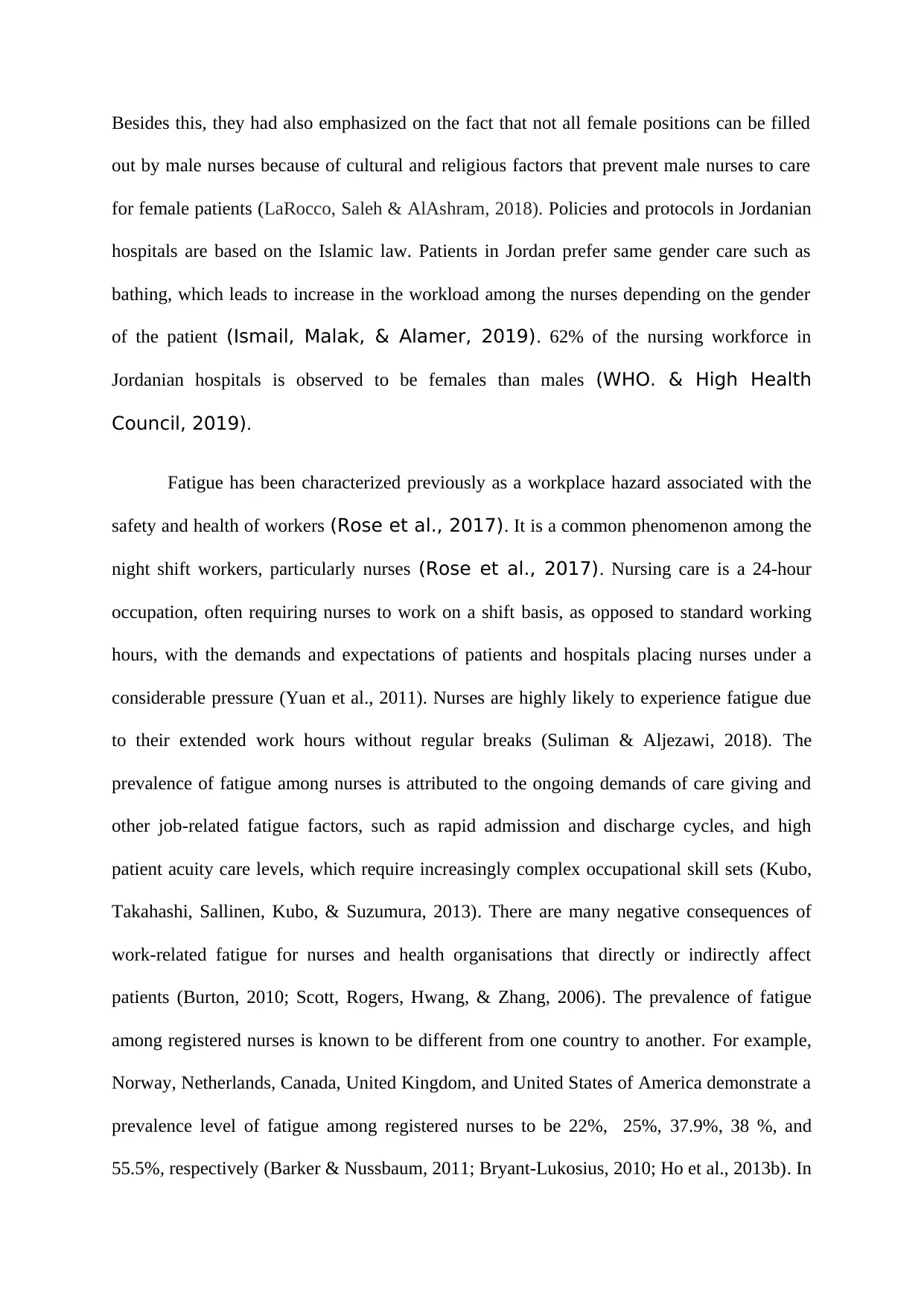
Besides this, they had also emphasized on the fact that not all female positions can be filled
out by male nurses because of cultural and religious factors that prevent male nurses to care
for female patients (LaRocco, Saleh & AlAshram, 2018). Policies and protocols in Jordanian
hospitals are based on the Islamic law. Patients in Jordan prefer same gender care such as
bathing, which leads to increase in the workload among the nurses depending on the gender
of the patient (Ismail, Malak, & Alamer, 2019). 62% of the nursing workforce in
Jordanian hospitals is observed to be females than males (WHO. & High Health
Council, 2019).
Fatigue has been characterized previously as a workplace hazard associated with the
safety and health of workers (Rose et al., 2017). It is a common phenomenon among the
night shift workers, particularly nurses (Rose et al., 2017). Nursing care is a 24-hour
occupation, often requiring nurses to work on a shift basis, as opposed to standard working
hours, with the demands and expectations of patients and hospitals placing nurses under a
considerable pressure (Yuan et al., 2011). Nurses are highly likely to experience fatigue due
to their extended work hours without regular breaks (Suliman & Aljezawi, 2018). The
prevalence of fatigue among nurses is attributed to the ongoing demands of care giving and
other job-related fatigue factors, such as rapid admission and discharge cycles, and high
patient acuity care levels, which require increasingly complex occupational skill sets (Kubo,
Takahashi, Sallinen, Kubo, & Suzumura, 2013). There are many negative consequences of
work-related fatigue for nurses and health organisations that directly or indirectly affect
patients (Burton, 2010; Scott, Rogers, Hwang, & Zhang, 2006). The prevalence of fatigue
among registered nurses is known to be different from one country to another. For example,
Norway, Netherlands, Canada, United Kingdom, and United States of America demonstrate a
prevalence level of fatigue among registered nurses to be 22%, 25%, 37.9%, 38 %, and
55.5%, respectively (Barker & Nussbaum, 2011; Bryant-Lukosius, 2010; Ho et al., 2013b). In
out by male nurses because of cultural and religious factors that prevent male nurses to care
for female patients (LaRocco, Saleh & AlAshram, 2018). Policies and protocols in Jordanian
hospitals are based on the Islamic law. Patients in Jordan prefer same gender care such as
bathing, which leads to increase in the workload among the nurses depending on the gender
of the patient (Ismail, Malak, & Alamer, 2019). 62% of the nursing workforce in
Jordanian hospitals is observed to be females than males (WHO. & High Health
Council, 2019).
Fatigue has been characterized previously as a workplace hazard associated with the
safety and health of workers (Rose et al., 2017). It is a common phenomenon among the
night shift workers, particularly nurses (Rose et al., 2017). Nursing care is a 24-hour
occupation, often requiring nurses to work on a shift basis, as opposed to standard working
hours, with the demands and expectations of patients and hospitals placing nurses under a
considerable pressure (Yuan et al., 2011). Nurses are highly likely to experience fatigue due
to their extended work hours without regular breaks (Suliman & Aljezawi, 2018). The
prevalence of fatigue among nurses is attributed to the ongoing demands of care giving and
other job-related fatigue factors, such as rapid admission and discharge cycles, and high
patient acuity care levels, which require increasingly complex occupational skill sets (Kubo,
Takahashi, Sallinen, Kubo, & Suzumura, 2013). There are many negative consequences of
work-related fatigue for nurses and health organisations that directly or indirectly affect
patients (Burton, 2010; Scott, Rogers, Hwang, & Zhang, 2006). The prevalence of fatigue
among registered nurses is known to be different from one country to another. For example,
Norway, Netherlands, Canada, United Kingdom, and United States of America demonstrate a
prevalence level of fatigue among registered nurses to be 22%, 25%, 37.9%, 38 %, and
55.5%, respectively (Barker & Nussbaum, 2011; Bryant-Lukosius, 2010; Ho et al., 2013b). In
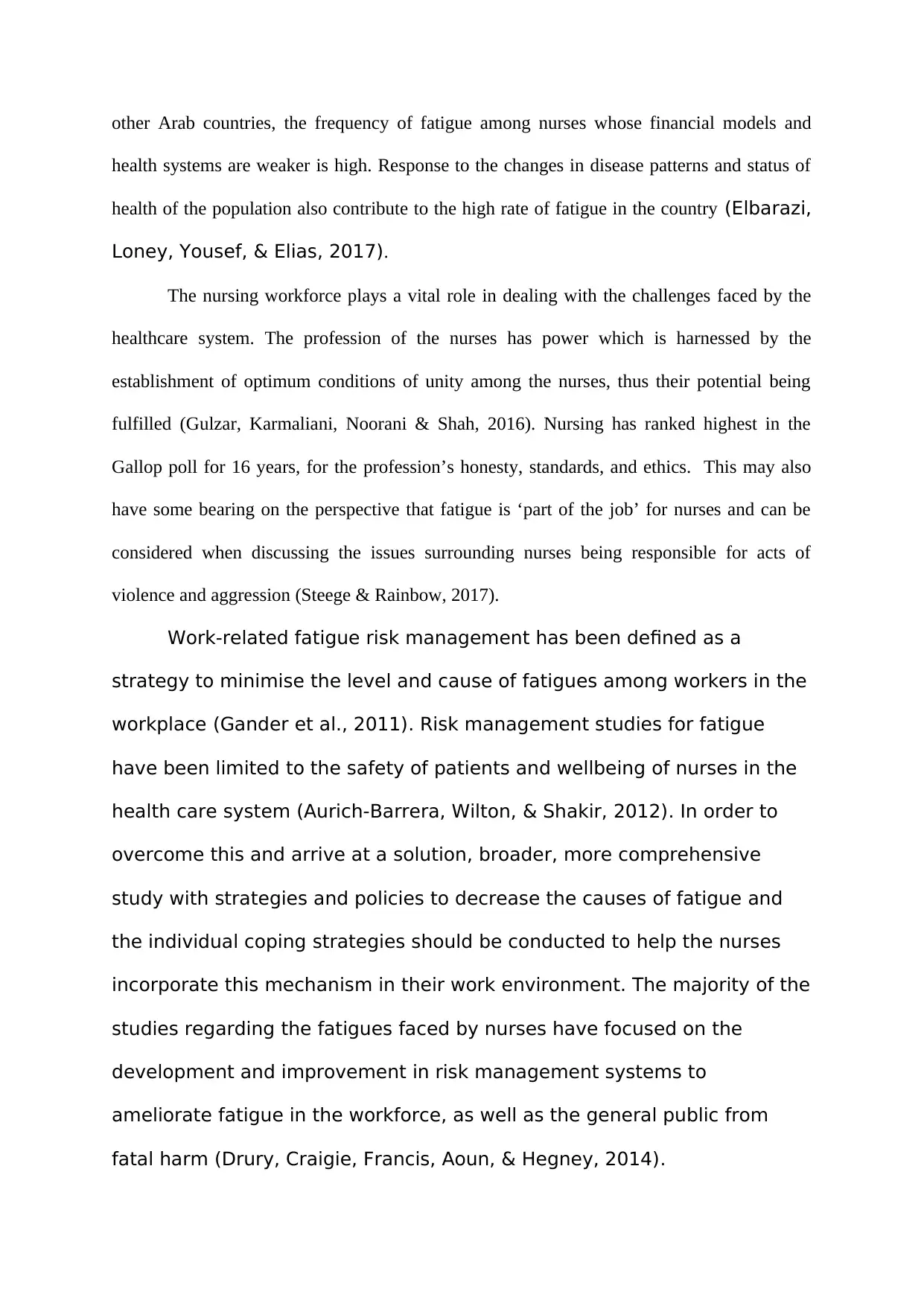
other Arab countries, the frequency of fatigue among nurses whose financial models and
health systems are weaker is high. Response to the changes in disease patterns and status of
health of the population also contribute to the high rate of fatigue in the country (Elbarazi,
Loney, Yousef, & Elias, 2017).
The nursing workforce plays a vital role in dealing with the challenges faced by the
healthcare system. The profession of the nurses has power which is harnessed by the
establishment of optimum conditions of unity among the nurses, thus their potential being
fulfilled (Gulzar, Karmaliani, Noorani & Shah, 2016). Nursing has ranked highest in the
Gallop poll for 16 years, for the profession’s honesty, standards, and ethics. This may also
have some bearing on the perspective that fatigue is ‘part of the job’ for nurses and can be
considered when discussing the issues surrounding nurses being responsible for acts of
violence and aggression (Steege & Rainbow, 2017).
Work-related fatigue risk management has been defined as a
strategy to minimise the level and cause of fatigues among workers in the
workplace (Gander et al., 2011). Risk management studies for fatigue
have been limited to the safety of patients and wellbeing of nurses in the
health care system (Aurich-Barrera, Wilton, & Shakir, 2012). In order to
overcome this and arrive at a solution, broader, more comprehensive
study with strategies and policies to decrease the causes of fatigue and
the individual coping strategies should be conducted to help the nurses
incorporate this mechanism in their work environment. The majority of the
studies regarding the fatigues faced by nurses have focused on the
development and improvement in risk management systems to
ameliorate fatigue in the workforce, as well as the general public from
fatal harm (Drury, Craigie, Francis, Aoun, & Hegney, 2014).
health systems are weaker is high. Response to the changes in disease patterns and status of
health of the population also contribute to the high rate of fatigue in the country (Elbarazi,
Loney, Yousef, & Elias, 2017).
The nursing workforce plays a vital role in dealing with the challenges faced by the
healthcare system. The profession of the nurses has power which is harnessed by the
establishment of optimum conditions of unity among the nurses, thus their potential being
fulfilled (Gulzar, Karmaliani, Noorani & Shah, 2016). Nursing has ranked highest in the
Gallop poll for 16 years, for the profession’s honesty, standards, and ethics. This may also
have some bearing on the perspective that fatigue is ‘part of the job’ for nurses and can be
considered when discussing the issues surrounding nurses being responsible for acts of
violence and aggression (Steege & Rainbow, 2017).
Work-related fatigue risk management has been defined as a
strategy to minimise the level and cause of fatigues among workers in the
workplace (Gander et al., 2011). Risk management studies for fatigue
have been limited to the safety of patients and wellbeing of nurses in the
health care system (Aurich-Barrera, Wilton, & Shakir, 2012). In order to
overcome this and arrive at a solution, broader, more comprehensive
study with strategies and policies to decrease the causes of fatigue and
the individual coping strategies should be conducted to help the nurses
incorporate this mechanism in their work environment. The majority of the
studies regarding the fatigues faced by nurses have focused on the
development and improvement in risk management systems to
ameliorate fatigue in the workforce, as well as the general public from
fatal harm (Drury, Craigie, Francis, Aoun, & Hegney, 2014).
⊘ This is a preview!⊘
Do you want full access?
Subscribe today to unlock all pages.

Trusted by 1+ million students worldwide
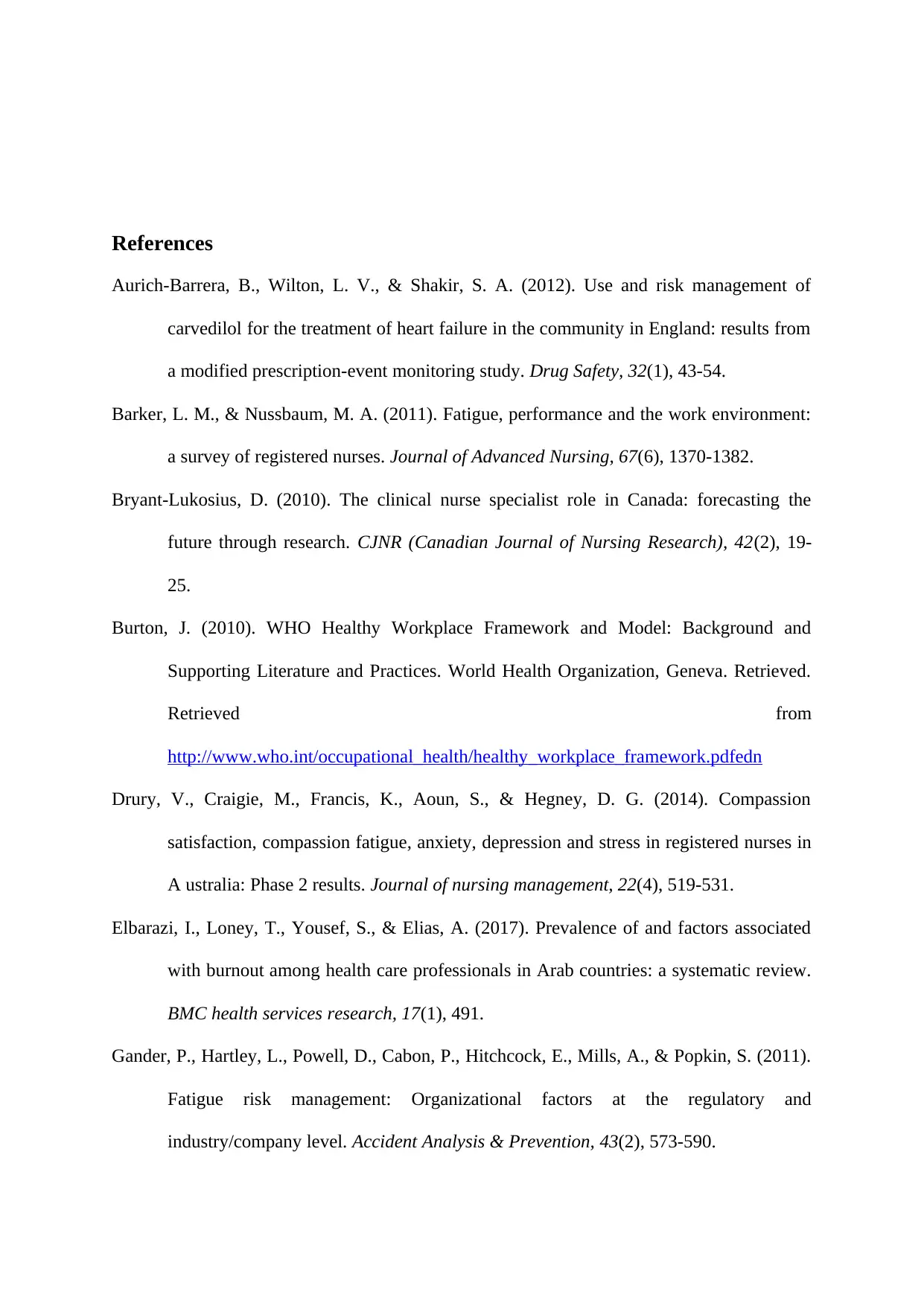
References
Aurich-Barrera, B., Wilton, L. V., & Shakir, S. A. (2012). Use and risk management of
carvedilol for the treatment of heart failure in the community in England: results from
a modified prescription-event monitoring study. Drug Safety, 32(1), 43-54.
Barker, L. M., & Nussbaum, M. A. (2011). Fatigue, performance and the work environment:
a survey of registered nurses. Journal of Advanced Nursing, 67(6), 1370-1382.
Bryant-Lukosius, D. (2010). The clinical nurse specialist role in Canada: forecasting the
future through research. CJNR (Canadian Journal of Nursing Research), 42(2), 19-
25.
Burton, J. (2010). WHO Healthy Workplace Framework and Model: Background and
Supporting Literature and Practices. World Health Organization, Geneva. Retrieved.
Retrieved from
http://www.who.int/occupational_health/healthy_workplace_framework.pdfedn
Drury, V., Craigie, M., Francis, K., Aoun, S., & Hegney, D. G. (2014). Compassion
satisfaction, compassion fatigue, anxiety, depression and stress in registered nurses in
A ustralia: Phase 2 results. Journal of nursing management, 22(4), 519-531.
Elbarazi, I., Loney, T., Yousef, S., & Elias, A. (2017). Prevalence of and factors associated
with burnout among health care professionals in Arab countries: a systematic review.
BMC health services research, 17(1), 491.
Gander, P., Hartley, L., Powell, D., Cabon, P., Hitchcock, E., Mills, A., & Popkin, S. (2011).
Fatigue risk management: Organizational factors at the regulatory and
industry/company level. Accident Analysis & Prevention, 43(2), 573-590.
Aurich-Barrera, B., Wilton, L. V., & Shakir, S. A. (2012). Use and risk management of
carvedilol for the treatment of heart failure in the community in England: results from
a modified prescription-event monitoring study. Drug Safety, 32(1), 43-54.
Barker, L. M., & Nussbaum, M. A. (2011). Fatigue, performance and the work environment:
a survey of registered nurses. Journal of Advanced Nursing, 67(6), 1370-1382.
Bryant-Lukosius, D. (2010). The clinical nurse specialist role in Canada: forecasting the
future through research. CJNR (Canadian Journal of Nursing Research), 42(2), 19-
25.
Burton, J. (2010). WHO Healthy Workplace Framework and Model: Background and
Supporting Literature and Practices. World Health Organization, Geneva. Retrieved.
Retrieved from
http://www.who.int/occupational_health/healthy_workplace_framework.pdfedn
Drury, V., Craigie, M., Francis, K., Aoun, S., & Hegney, D. G. (2014). Compassion
satisfaction, compassion fatigue, anxiety, depression and stress in registered nurses in
A ustralia: Phase 2 results. Journal of nursing management, 22(4), 519-531.
Elbarazi, I., Loney, T., Yousef, S., & Elias, A. (2017). Prevalence of and factors associated
with burnout among health care professionals in Arab countries: a systematic review.
BMC health services research, 17(1), 491.
Gander, P., Hartley, L., Powell, D., Cabon, P., Hitchcock, E., Mills, A., & Popkin, S. (2011).
Fatigue risk management: Organizational factors at the regulatory and
industry/company level. Accident Analysis & Prevention, 43(2), 573-590.
Paraphrase This Document
Need a fresh take? Get an instant paraphrase of this document with our AI Paraphraser
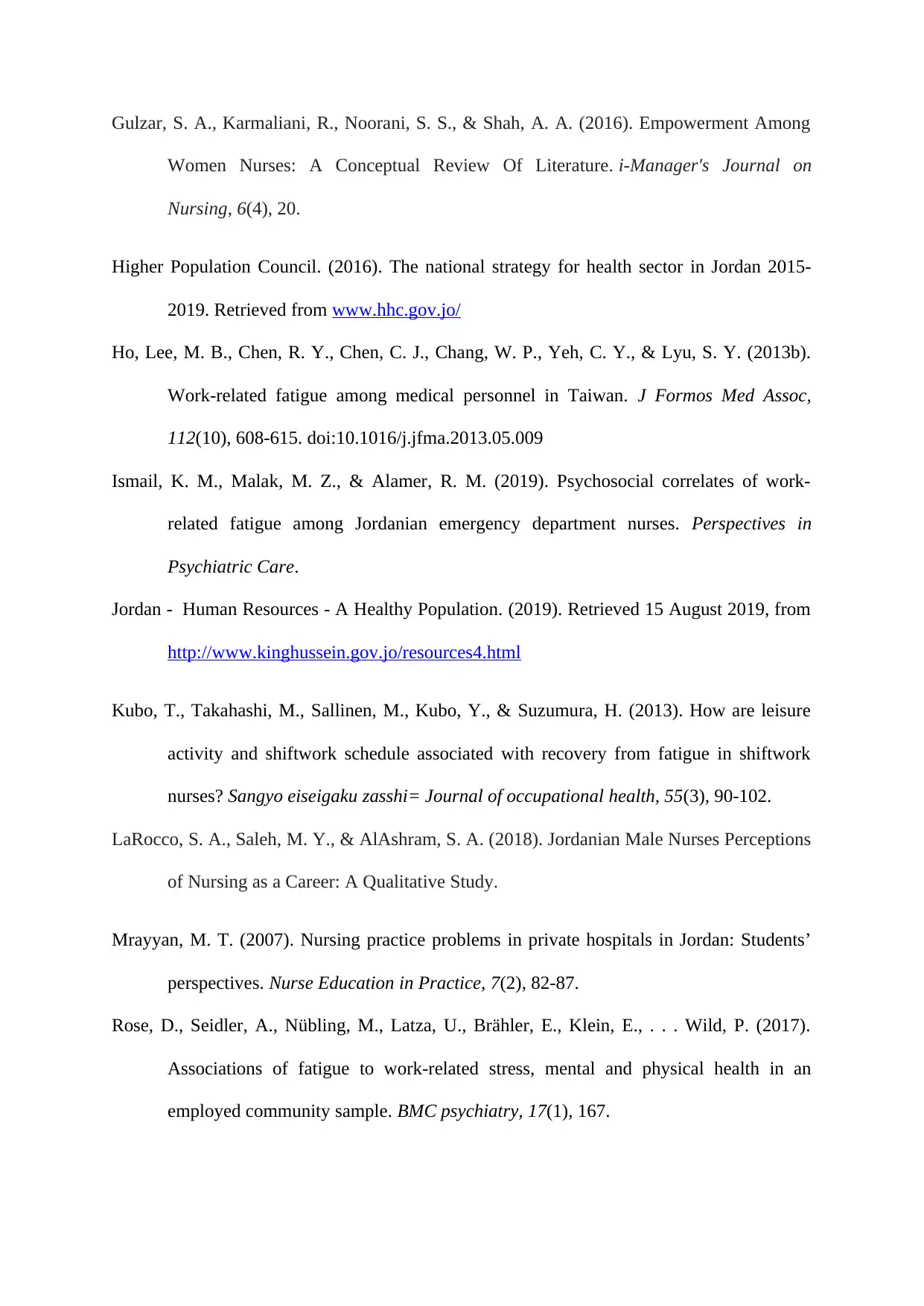
Gulzar, S. A., Karmaliani, R., Noorani, S. S., & Shah, A. A. (2016). Empowerment Among
Women Nurses: A Conceptual Review Of Literature. i-Manager's Journal on
Nursing, 6(4), 20.
Higher Population Council. (2016). The national strategy for health sector in Jordan 2015-
2019. Retrieved from www.hhc.gov.jo/
Ho, Lee, M. B., Chen, R. Y., Chen, C. J., Chang, W. P., Yeh, C. Y., & Lyu, S. Y. (2013b).
Work-related fatigue among medical personnel in Taiwan. J Formos Med Assoc,
112(10), 608-615. doi:10.1016/j.jfma.2013.05.009
Ismail, K. M., Malak, M. Z., & Alamer, R. M. (2019). Psychosocial correlates of work-
related fatigue among Jordanian emergency department nurses. Perspectives in
Psychiatric Care.
Jordan - Human Resources - A Healthy Population. (2019). Retrieved 15 August 2019, from
http://www.kinghussein.gov.jo/resources4.html
Kubo, T., Takahashi, M., Sallinen, M., Kubo, Y., & Suzumura, H. (2013). How are leisure
activity and shiftwork schedule associated with recovery from fatigue in shiftwork
nurses? Sangyo eiseigaku zasshi= Journal of occupational health, 55(3), 90-102.
LaRocco, S. A., Saleh, M. Y., & AlAshram, S. A. (2018). Jordanian Male Nurses Perceptions
of Nursing as a Career: A Qualitative Study.
Mrayyan, M. T. (2007). Nursing practice problems in private hospitals in Jordan: Students’
perspectives. Nurse Education in Practice, 7(2), 82-87.
Rose, D., Seidler, A., Nübling, M., Latza, U., Brähler, E., Klein, E., . . . Wild, P. (2017).
Associations of fatigue to work-related stress, mental and physical health in an
employed community sample. BMC psychiatry, 17(1), 167.
Women Nurses: A Conceptual Review Of Literature. i-Manager's Journal on
Nursing, 6(4), 20.
Higher Population Council. (2016). The national strategy for health sector in Jordan 2015-
2019. Retrieved from www.hhc.gov.jo/
Ho, Lee, M. B., Chen, R. Y., Chen, C. J., Chang, W. P., Yeh, C. Y., & Lyu, S. Y. (2013b).
Work-related fatigue among medical personnel in Taiwan. J Formos Med Assoc,
112(10), 608-615. doi:10.1016/j.jfma.2013.05.009
Ismail, K. M., Malak, M. Z., & Alamer, R. M. (2019). Psychosocial correlates of work-
related fatigue among Jordanian emergency department nurses. Perspectives in
Psychiatric Care.
Jordan - Human Resources - A Healthy Population. (2019). Retrieved 15 August 2019, from
http://www.kinghussein.gov.jo/resources4.html
Kubo, T., Takahashi, M., Sallinen, M., Kubo, Y., & Suzumura, H. (2013). How are leisure
activity and shiftwork schedule associated with recovery from fatigue in shiftwork
nurses? Sangyo eiseigaku zasshi= Journal of occupational health, 55(3), 90-102.
LaRocco, S. A., Saleh, M. Y., & AlAshram, S. A. (2018). Jordanian Male Nurses Perceptions
of Nursing as a Career: A Qualitative Study.
Mrayyan, M. T. (2007). Nursing practice problems in private hospitals in Jordan: Students’
perspectives. Nurse Education in Practice, 7(2), 82-87.
Rose, D., Seidler, A., Nübling, M., Latza, U., Brähler, E., Klein, E., . . . Wild, P. (2017).
Associations of fatigue to work-related stress, mental and physical health in an
employed community sample. BMC psychiatry, 17(1), 167.
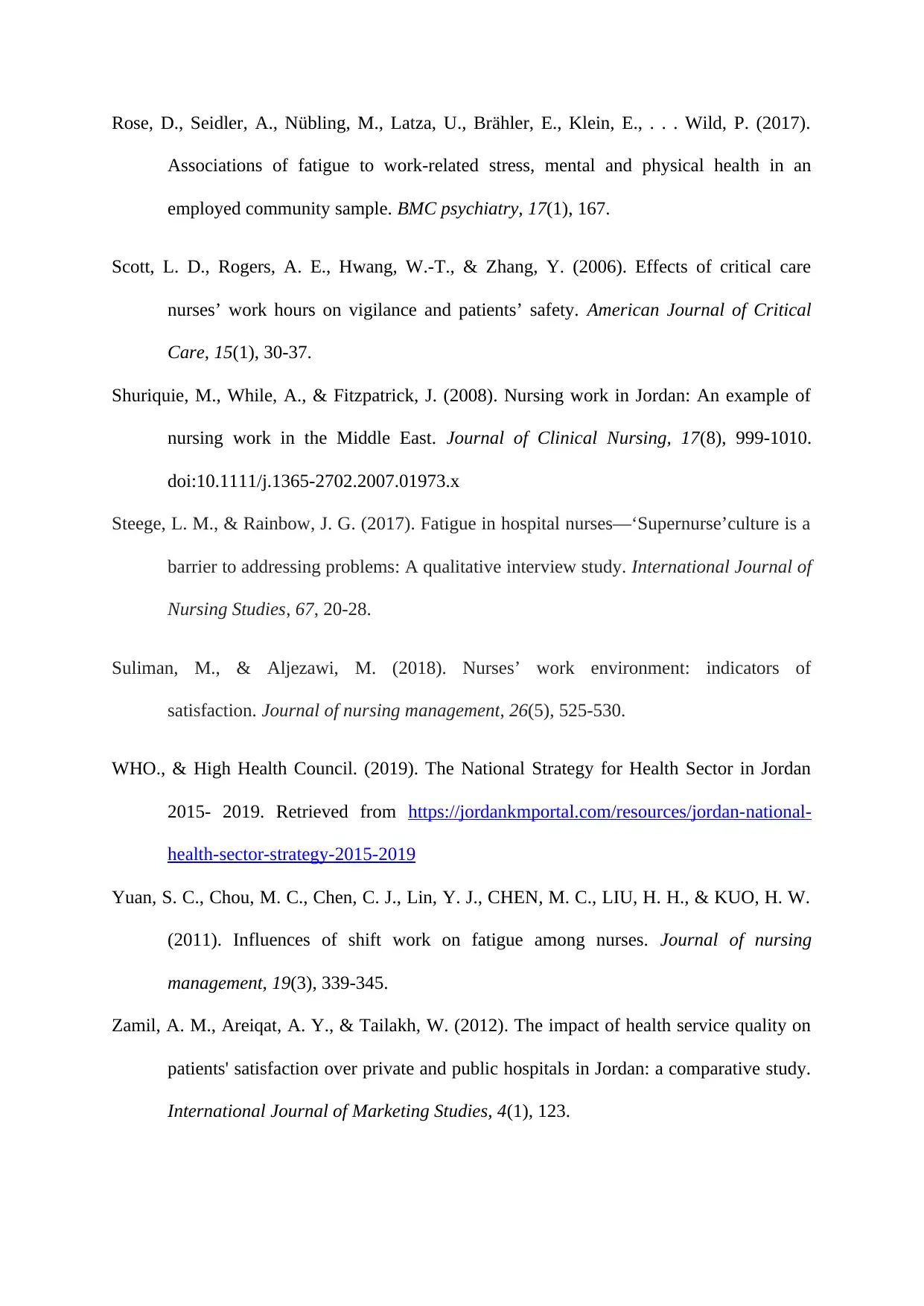
Rose, D., Seidler, A., Nübling, M., Latza, U., Brähler, E., Klein, E., . . . Wild, P. (2017).
Associations of fatigue to work-related stress, mental and physical health in an
employed community sample. BMC psychiatry, 17(1), 167.
Scott, L. D., Rogers, A. E., Hwang, W.-T., & Zhang, Y. (2006). Effects of critical care
nurses’ work hours on vigilance and patients’ safety. American Journal of Critical
Care, 15(1), 30-37.
Shuriquie, M., While, A., & Fitzpatrick, J. (2008). Nursing work in Jordan: An example of
nursing work in the Middle East. Journal of Clinical Nursing, 17(8), 999-1010.
doi:10.1111/j.1365-2702.2007.01973.x
Steege, L. M., & Rainbow, J. G. (2017). Fatigue in hospital nurses—‘Supernurse’culture is a
barrier to addressing problems: A qualitative interview study. International Journal of
Nursing Studies, 67, 20-28.
Suliman, M., & Aljezawi, M. (2018). Nurses’ work environment: indicators of
satisfaction. Journal of nursing management, 26(5), 525-530.
WHO., & High Health Council. (2019). The National Strategy for Health Sector in Jordan
2015- 2019. Retrieved from https://jordankmportal.com/resources/jordan-national-
health-sector-strategy-2015-2019
Yuan, S. C., Chou, M. C., Chen, C. J., Lin, Y. J., CHEN, M. C., LIU, H. H., & KUO, H. W.
(2011). Influences of shift work on fatigue among nurses. Journal of nursing
management, 19(3), 339-345.
Zamil, A. M., Areiqat, A. Y., & Tailakh, W. (2012). The impact of health service quality on
patients' satisfaction over private and public hospitals in Jordan: a comparative study.
International Journal of Marketing Studies, 4(1), 123.
Associations of fatigue to work-related stress, mental and physical health in an
employed community sample. BMC psychiatry, 17(1), 167.
Scott, L. D., Rogers, A. E., Hwang, W.-T., & Zhang, Y. (2006). Effects of critical care
nurses’ work hours on vigilance and patients’ safety. American Journal of Critical
Care, 15(1), 30-37.
Shuriquie, M., While, A., & Fitzpatrick, J. (2008). Nursing work in Jordan: An example of
nursing work in the Middle East. Journal of Clinical Nursing, 17(8), 999-1010.
doi:10.1111/j.1365-2702.2007.01973.x
Steege, L. M., & Rainbow, J. G. (2017). Fatigue in hospital nurses—‘Supernurse’culture is a
barrier to addressing problems: A qualitative interview study. International Journal of
Nursing Studies, 67, 20-28.
Suliman, M., & Aljezawi, M. (2018). Nurses’ work environment: indicators of
satisfaction. Journal of nursing management, 26(5), 525-530.
WHO., & High Health Council. (2019). The National Strategy for Health Sector in Jordan
2015- 2019. Retrieved from https://jordankmportal.com/resources/jordan-national-
health-sector-strategy-2015-2019
Yuan, S. C., Chou, M. C., Chen, C. J., Lin, Y. J., CHEN, M. C., LIU, H. H., & KUO, H. W.
(2011). Influences of shift work on fatigue among nurses. Journal of nursing
management, 19(3), 339-345.
Zamil, A. M., Areiqat, A. Y., & Tailakh, W. (2012). The impact of health service quality on
patients' satisfaction over private and public hospitals in Jordan: a comparative study.
International Journal of Marketing Studies, 4(1), 123.
⊘ This is a preview!⊘
Do you want full access?
Subscribe today to unlock all pages.

Trusted by 1+ million students worldwide
1 out of 6
Related Documents
Your All-in-One AI-Powered Toolkit for Academic Success.
+13062052269
info@desklib.com
Available 24*7 on WhatsApp / Email
![[object Object]](/_next/static/media/star-bottom.7253800d.svg)
Unlock your academic potential
Copyright © 2020–2025 A2Z Services. All Rights Reserved. Developed and managed by ZUCOL.




